
Naming every expedition participant in a telepresence-enabled mission is next to impossible! Many from dozens of institutions across the country have provided input into the expedition plan and are expected to participate. However, we've assembled information about the members of the science and remotely operated vehicle teams who are physically onboard NOAA Ship Okeanos Explorer, and whose voices you are likely to hear most often when watching the live video.
And of course, none of this exploration would be possible without the work of the dedicated NOAA Commissioned Officer Corps and civilians who operate NOAA Ship Okeanos Explorer as part of NOAA's fleet managed by NOAA's Office of Marine and Aviation.

Leg 4
Co-science Lead
Associate Professor of Biology, University of Louisiana at Lafayette
Scott France studies the evolution of deep-sea invertebrates. He was attracted to a career in marine biology when, as a fine arts major at Concordia University, he took an elective course in oceanography and was captivated learning about the discovery of deep-sea hydrothermal vents. That new knowledge drove his desire to visit and explore the deep sea himself, and he immediately switched majors to Biology. Scott earned his B.S. in Biology at Concordia University in 1986 and a PhD in Oceanography from the Scripps Institution of Oceanography, University of California, San Diego, in 1992. He has held postdoctoral positions at the Woods Hole Oceanographic Institution, the University of New Hampshire, and Harvard University and taught Evolution at Bowdoin College. He was on the faculty of the College of Charleston from 1997-2003, and received the Ray P. Authement College of Sciences Outstanding Professor Award at the University of Louisiana at Lafayette, where he has been a faculty member since 2004. Over his career, he has visited the deep-ocean floor off the Mariana Islands, Hawaii, Galapagos, California, Bahamas, and the western North Atlantic, and has previously participated in Okeanos Explorer telepresence-enabled missions as a scientist-on-shore. He and his students have analyzed genetic variation of deep-sea invertebrates, and in particular in deep-sea octocorals, from a variety of habitats, including hydrothermal vents, abyssal plains, seamounts, canyons, and trenches. Scott currently resides in Lafayette, Louisiana.
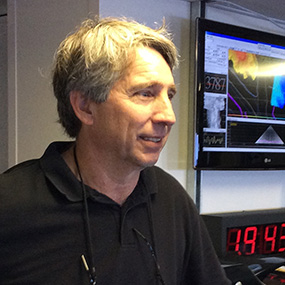
Legs 2, 3
Co-science Lead
Program Biologist
Hawaii Undersea Research Laboratory – University of Hawaii
Dr. Christopher Kelley is serving as the science lead for the three-year CAPSTONE project in the Pacific. He has been the program biologist for the Hawaii Undersea Research Laboratory (HURL) at the University of Hawaii for the last 15 years. His core responsibilities have included the identification of deep-water fish and invertebrates recorded during submersible and remotely operated vehicle (ROV) operations and the extraction of video annotations for inclusion in HURL’s deepwater animal database and online photo guide. He is also graduate faculty for the Oceanography Department as well as affiliate faculty at the Hawaii Institute of Marine Biology and serves on both masters and PhD graduate student committees.
In addition to his core responsibilities, Dr. Kelley has both led and worked on numerous external grants from federal and state agencies. Some projects have involved reviewing Essential Fish Habitat designations in Hawaii and elsewhere in the Pacific for the deep-water bottomfish fishery, as well as examining the impacts of bottom fishing and the effectiveness of bottomfish reserves. Other projects have involved the description of the deep-water communities living on manganese crusts in the Central Pacific, describing the deep water biological communities associated with disposed munitions off Pearl Harbor, and extracting and formatting HURL video records for inclusion in the new Deep Sea Coral Research and Technology Program national database of deep sea corals.
In addition to his deep-water biology work, Dr. Kelley has also lead a significant number of multibeam and sidescan sonar mapping projects throughout the Hawaiian archipelago, the latest of which involved 72 days of mapping in the Papahānaumokuākea Marine National Monument on board the R/V Falkor. His sidescan sonar towfish surveys off Oahu have led to the discovery of a number of submerged cultural resources.
Dr. Kelley received his Ph.D. in 1995 from the University of Hawaii while researching fish reproductive cycles. Prior to joining HURL, he traveled extensively, providing technical assistance for developing fish hatcheries in Indonesia, Taiwan, the Philippines, Egypt, and Cameroon, West Africa. He was also an aquanaut for the Hydrolab Undersea Habitat in 1982, assisting in a study on the ecology and social behavior of Caribbean angelfishes.
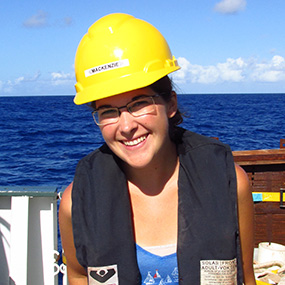
Leg 4
Co-science Lead
PhD Candidate, University of Hawaiʻi
Mackenzie Gerringer is working toward a Ph.D. in marine biology at the University of Hawaiʻi. Her current research interests center on the growth and adaptations of the planet’s deepest-living fishes. She first developed a passion for deep-sea biology while working at Whitman College on adaptations to high pressure. She has grown particularly fond of the hadal zone, participating in research cruises to the Kermadec, New Hebrides, and Mariana Trenches. After earning a bachelor’s degree in biology and German studies in 2012, Ms. Gerringer taught eighth- and ninth-grade English as a Fulbright Scholar in Bremen, Germany. She is delighted to continue exploring the weird and wonderful world of deep-sea fishes aboard the Okeanos Explorer.

Leg 3
Co-science Lead
Director, Protected Species Division, Pacific Islands Fisheries Science Center NOAA's National Marine Fisheries Service
As Director of the Protected Species Division at the Pacific Islands Fisheries Science Center, Dr. Frank Parrish is responsible for overseeing programs that conduct population assessments, ecological studies, and health and disease monitoring for monk seals, cetaceans, and sea turtles in the U.S. Pacific Islands. Historically, his research emphasis is habitat ecology, and he has published on coral reef fish, subphotic fish, sharks, lobster, monk seals, and mesphotic and deep-sea corals. Dr. Parrish has extensive field experience at sea and in remote camps working with scuba, remote-operated cameras, manned submersibles, and animal-borne instrumentation. He currently serves as the center’s representative for development of advanced sampling technology. Dr. Parrish has been in Hawaii since high school and he obtained his bachelors, masters, and Ph.D degrees from the University of Hawaii. He is joining the team as the Co-Science Lead for Leg 3 of the 2015 Hohonu Moana expedition.
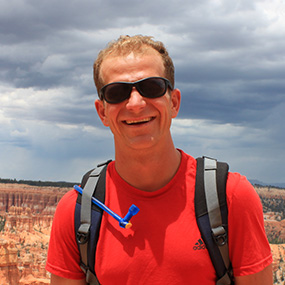
Leg 2
Research Specialist, NOAA Papahānaumokuākea Marine National Monument
Daniel Wagner received his Ph.D. in biological oceanography from the University of Hawaiʻi in 2011. Prior to that, Daniel received a B.S. in biology from Hawaiʻi Pacific University in 2005, and an M.S. in biological oceanography from the University of Hawaiʻi in 2008.
Daniel has conducted research on Hawaii’s deep-sea reefs for more than a decade and participated in over 20 research expeditions that have surveyed deep-water habitats using technical SCUBA diving, manned submersibles, and remotely operated vehicles. Daniel is interested in the taxonomy, life history and ecology of deep-sea corals, particularly of black corals.
He is serving as a co-science lead during the first ROV expedition to the Northwestern Hawaiian Islands, and will help coordinate the science objectives during the expedition.
Daniel is originally from Ecuador, but resides in Honolulu, Hawaiʻi.
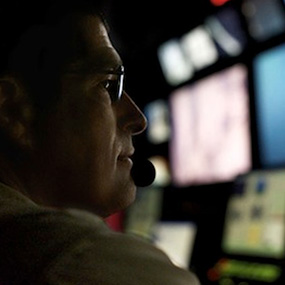
Legs 2, 3
Video/Audio Engineer
Joe Biscotti is an award-winning broadcast engineer, cameraman, editor, satellite engineer, and aerial drone pilot with 36 years of experience in the broadcast media world. Joe has a long history with Good Morning America and ABC News, with many firsts over the course of his career. Joe joined the Ocean Exploration program to help us establish a very high-quality standard for our underwater imaging capability and is one of our key underwater camera operators. He has spent a great deal of time in Iraq, the Gulf of Mexico, and recently Vietnam setting up a live broadcast from the world's largest cave system. His very high standard of expertise is always in demand. He is a member of the Society of Broadcast Engineers and his list of accomplishments include, but are not limited to, an Emmy for ABC Prime Time Live, Emmy nominations nine times for editing and ten times Emmy nominated for field audio. Joe is also the winner of 10 Cine Golden Eagle awards and when not traveling to the far reaches of the world, he resides in Weston, Florida.
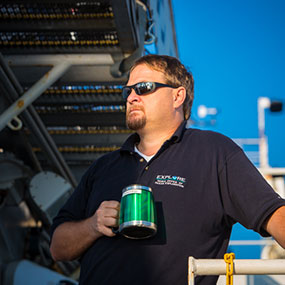
Electronic Systems Engineer
Global Foundation for Ocean Exploration
Roland Brian brings 29 years of experience and a keen eye for precision HD video to the program as a video/satellite and telepresence engineer. Roland began his career in the U.S. Air Force where he worked as a Satellite Communications Engineering Technician with visions of working on the U.S. Space Station. He traded in that quest for one of deep-ocean exploration and sharing beautiful imagery with the world. He has worked with the NOAA Office of Ocean Exploration and Research (OER) and the Okeanos Explorer Program since 2009 and has been engaged in every telepresence-enabled remotely operated vehicle (ROV) expedition. He has also provided services for other projects using OER’s mobile telepresence system, including the 2012 Ring of Fire Expedition. His duties aboard NOAA Ship Okeanos Explorer include operation and maintenance of the ship's Telepresence and video systems, including on ROV Deep Discoverer and the Seirios camera platform. Again, Roland’s experience embodies the breadth and depth of knowledge the OER program encourages. When not fine-tuning the video and telepresence systems or training and mentoring new team members, he's actively involved in the editing process of our ever-expanding ocean exploration video library. While not at sea, Roland enjoys life with his wife and family in sunny Sarasota, Florida.
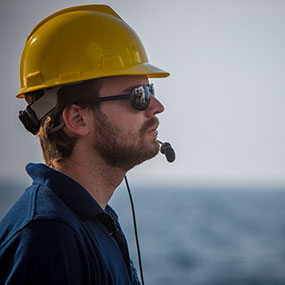
Mechanical Engineer
Global Foundation for Ocean Exploration
Joshua Carlson attended the University of Massachusetts, Dartmouth, where he received a B.S. in Mechanical Engineering with minor in Business Administration. He went on to receive his M.S. in Marine Observation Technology from the University of Massachusetts, Dartmouth School for Marine Science and Technology. Josh has a diverse background, encompassing the use of autonomous underwater vehicles (AUVs) and other types of ocean observation platforms for the purpose of studying ocean turbulence. He has designed and built a deep-ocean camera platform for filming deep-water krill in the Antarctic Ocean and provided mechanical engineering and software capabilities on the Woods Hole Oceanographic AUV Sentry during a recent cruise aboard the NOAA ship Okeanos Explorer. In his current position with NOAA’s Ocean Exploration program, Josh provides engineering, programming, and at-sea support, acting in the capacity of navigator, pilot, and co-pilot for NOAA’s 6000-meter-rated remotely operated vehicle system, Deep Discoverer. His broad range of skills in both engineering and software control development makes him an invaluable member of our team. When not traveling, Josh resides in Fairhaven, Massachusetts.
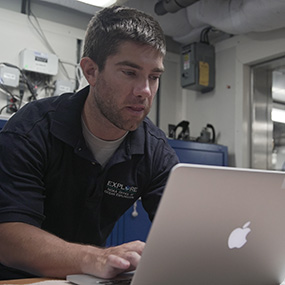
Mechanical Engineer
Global Foundation for Ocean Exploration
Matt Dornback brings a background of marine science, data management, and outreach to the NOAA National Centers for Environmental Information. Currently he works with the Deep-Sea Coral Research and Technology Program to manage their data and make it available to the public through deepseacoraldata.noaa.gov. He holds a B.S. in Marine Biology from the University of North Carolina Wilmington and a M.S. in Biological Oceanography from the University of Southern Mississippi Department of Marine Science. During cruises, Matt manages the data collected from samples collected by the ROV and works with the Science Leads to properly handle and preserve the specimens for further scientific analysis.
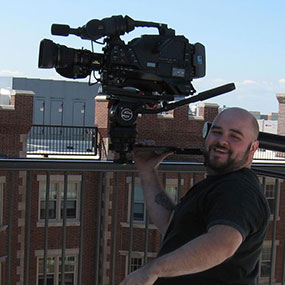
Legs 2, 4
Telepresence Engineer, NOAA Office of Ocean Exploration and Research
passion for science, technology, and story telling. Over the course of his career he has been an improv comedian, a crime reporter in New York City, a Distance Education Technical Director at Harvard, a Field Operations coordinator at the Massachusetts Institute of Technology (MIT), and freelance education consultant. His early work with Northeastern University and MIT helped pioneer technology and techniques for distance learning that have become standard practice today. He was an early entrant into the nascent field of Massive Online Open Course education and produced some of the first courses featured on EdX. His live broadcast work with both the International Space Station (for NASA TV and MIT) and the Okeanos Explorer deep-sea exploration program (for NOAA) means he has connected some of the highest and deepest live broadcast origins in the history of mankind. He remains unsure if this qualifies as a Guinness World record or not.
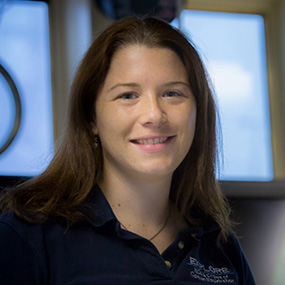
Legs 2, 3
Expedition Manager, NOAA Office of Ocean Exploration and Research
Kelley Elliott is the Senior Expedition Manager for the NOAA Office of Ocean Exploration and Research’s telepresence-enabled exploration program. She holds a Master’s degree in Maritime Archaeology from the University of Southampton and a Bachelor’s degree in Environmental Conservation from New Century College, George Mason University. Kelley is responsible for planning, coordinating, and managing expeditions conducted by NOAA Ship Okeanos Explorer. She has coordinated 10 Okeanos’ cruises since joining the operation in 2009, including five telepresence-enabled remotely operated vehicle cruises and one telepresence-enabled autonomous underwater vehicle cruise. In this role, she acts as a liaison for science and operational partners onshore as well as coordinating the mission planning process between all personnel onboard the ship. Her background demonstrates the depth of knowledge and expertise the Ocean Exploration Program requires and embodies. In addition to geographic information system, video editing, and web publishing expertise, Kelley is an excellent writer and frequently develops and edits articles for publication on NOAA’s website.
Over the last decade, her combined professional and academic field experiences have taken her around the globe investigating a diversity of science topics from Arctic Ocean ecology, tropical ecosystems, and submerged cultural heritage to deep-sea ecosystems including hydrothermal vents, gas seeps, submarine canyons, and deep-sea coral habitats. An explorer at heart, Kelley spends most of her spare time exploring the great outdoors from the volcanos of Nicaragua to the trails surrounding her home in Reston, Virginia.
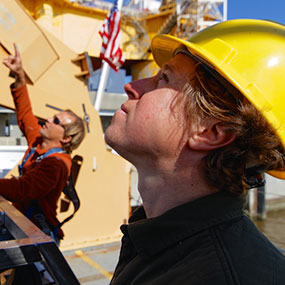
Leg 3
Mechanical Engineer
Todd Gregory received his B.S. in Naval Architecture and Marine Engineering from Webb Institute in 1999 and his M.S. of Ocean Engineering from the University of Hawaii at Manoa in 2001. From 2002 to 2010, Todd was employed by Dr. Robert Ballard’s Institute for Exploration, where he served as the principle mechanical/ hydraulic designer for the remotely operated vehicle (ROV) system Hercules. He has served as a Guest Investigator at the Woods Hole Oceanographic Institution and as an Associate Marine Development Engineer at the University of Rhode Island-Graduate School of Oceanography and is currently a Mechanical Engineering Consultant to NOAA’s Office of Ocean Exploration and Research (OER). Todd is our principle mechanical engineer for OER’s 6000-meter rated, two-body ROV system Deep Discoverer and Seirios, and is one of the chief pilots during our offshore operations. He has participated in numerous international research expeditions and is a tremendous asset to the oceanographic community.His efforts in mentoring our newer engineers and impeccable attention to detail are but a few of his many contributions to the Ocean Exploration program.Todd currently resides in North Kingstown, Rhode Island.
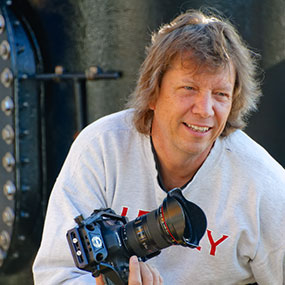
Photographer and Producer
Global Foundation for Ocean Exploration
For 34 years, Emmy-award winning photographer and producer Art Howard has helped viewers experience life through images from 50 countries and seven continents. A native North Carolinian, Art has followed researchers aboard multiple deep-sea missions, documenting the excitement and challenges of offshore reef exploration. Art will use the latest video technology to bring viewers as close as possible to life at sea from the surface to depths of 3,000 feet, capturing both the scientists and the life they seek to understand. Howard has spent the last 11 years independently producing media for the North Carolina Museum of Natural Sciences.
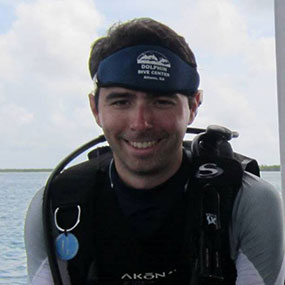
Expedition Coordinator
NOAA Office of Ocean Exploration and Research
When Brian was five years old, he decided that he wanted to be a marine biologist and explore the unknown reaches of the planet, and now he has his dream job. Originally from land-locked Athens, Georgia, Brian grew up fascinated with marine mammals and the ocean. Brian attended the Honors College at the College of Charleston (CofC) in South Carolina where he majored in Marine Biology and minored in Marine Geology. While at CofC, he had the opportunity to sail on multiple research cruises aboard two different NOAA research vessels and meet multiple NOAA Commissioned Officer Corps members. Shortly after graduating with honors from CofC, Brian was awarded a commission in the NOAA Corps. His first sea assignment was as a Junior Officer aboard NOAA’s Okeanos Explorer, America’s Ship for Ocean Exploration. Upon completion, Brian was then assigned to NOAA’s Ocean Exploration Program, where he is now an Expedition Coordinator for the Okeanos Explorer. Brian has participated in or led more than 25 expeditions of exploration taking him to two oceans (Atlantic and Pacific), three continents (North America, South America and Asia), and through the waters of more than five countries (Ecuador, Panama, Costa Rica, Honduras, Indonesia). As Expedition Coordinator, Brian is responsible for overseeing all aspects of an expedition, including arranging logistics, planning science operations, obtaining international clearances, and coordinating public outreach.
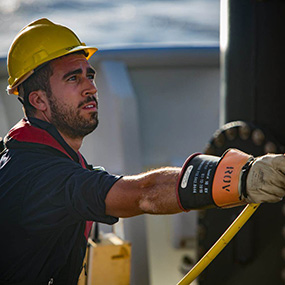
Electrical Engineer
Global Foundation for Ocean Exploration
Sean Kennison holds a B.S. in Mechanical Engineering with a minor in Engineering Mechanics from Pennsylvania State University. He first sailed on the Okeanos Explorer as an intern and member of the Engineering Group, where he performed tasks associated with the launch, operation, and recovery of the ROV system. He has also worked shoreside, designing mechanical parts for the ROVs and assisting with assembly and testing of previously and newly installed equipment. Sean also assisted with installing electronics, testing, data analysis, and troubleshooting on the vehicle. Most recently, he assisted in assembling and modifying a new bio storage box for the Deep Discoverer ROV. While at Penn State, Sean served as team leader on a number of engineering design projects.
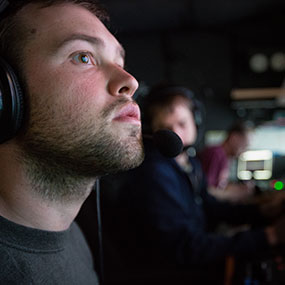
Electrical Engineer
Global Foundation for Ocean Exploration
Jeff Lanning holds a B.S. in Electrical Engineering from the University of Vermont. He started his career as an intern with Greensea Systems, Inc., where he worked on design, development, and integration of components and software associated with remotely operated vehicles and autonomous underwater vehicle systems.
Jeff is one of our youngest members and came to our group with a desire to learn new and complex electrical systems. Electrical engineers interested in and capable of working on deep submergence systems are one of the hardest positions to fill. Jeff has done a great job as a key member of the team that built Deep Discoverer and has become a skilled pilot, co-pilot, and navigator. His contribution to ocean exploration is certainly something to be proud of and we hope that other young engineers will be inspired by what he has accomplished. Jeff currently resides in Vermont.
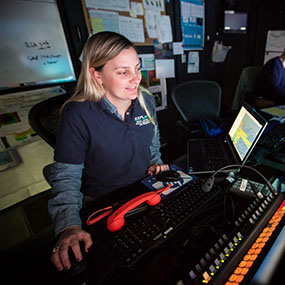
Leg 2
Physical Scientist/Mapping Lead, NOAA Office of Ocean Exploration and Research
Elizabeth (Meme) Lobecker is a Physical Scientist with the NOAA Office of Ocean Exploration and Research (OER). She has led or sailed on over 20 cruises on NOAA Ship Okeanos Explorer. When working on shore at the Integrated Ocean and Coastal Mapping (IOCM) center at the University of New Hampshire, she facilitates data archival procedures with the National Geophysical Data Center and collaborates with other scientists onOkeanos Explorerexploration missions. Her interests lie in facilitating the use of Okeanos mapping data by as many data users as possible.
Prior to starting her work with OER, Meme began her career in hydrography in 2002 at Science Applications International Corporation, Inc. (now Leidos) where she spent five years mapping the U.S. east coast, the Gulf of Mexico, and Alaska, primarily for NOAA and U.S. Geological Survey contracts. She was also a main in-house software tester for SAIC's multibeam acquisition and processing software suite. In 2007, Meme left SAIC to diversify her survey experience through field work in Papua New Guinea, the North Sea, and the Mediterranean Sea for various research and commercial purposes.
Meme completed her Masters degree in Marine Affairs at the University of Rhode Island in 2008, where her worked focused on the recent string of Californian and U.S. Supreme Court cases attempting to manage the potential effects of U.S. Navy mid-frequency sonar testing in the Southern California Range Complex on marine mammals. She holds a bachelor's degree from The George Washington University in Environmental Studies, with minors in geography and biology.
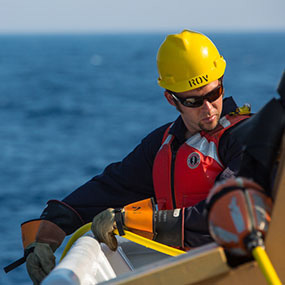
Legs 2, 4
Ocean/Mechanical Engineer, NOAA Office of Ocean Exploration and Research
Karl McLetchie is a graduate of the Massachusetts Institute of Technology. He holds B.S. and M.S. degrees in Ocean and Mechanical Engineering. After graduating, he worked as an engineer on the development of autonomous underwater vehicles and as a naval architect on the design of high-speed aluminum vessels. After a brief, two-year stint of delivering sailboats around the Caribbean, he started his own contracting company, SeaKnowledge, in 2008. Through SeaKnowledge, Karl works on the mechanical design and operation of underwater vehicles. Karl has worked on Okeanos Explorer for six seasons, in all positions on the ROV Team from Winch Operator to Dive Supervisor. When not on assignment for Ocean Exploration, Karl resides in Pemaquid, Maine.
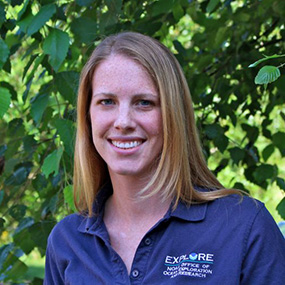
Leg 4
Physical Scientist/Hydrographer, NOAA Office of Ocean Exploration and Research
Lindsay earned her master's in Ocean Mapping from the University of New Hampshire in 2013 and her bachelor's degree in Geological Sciences from Brown University in 2007. Lindsay worked as a geologist in the environmental field for three years before returning to graduate school. In graduate school, Lindsay gained practical seafloor-mapping experience during research cruises to the Mediterranean Sea and Arctic Ocean. Lindsay joined the Ocean Exploration program in early 2014 as a Mapping Team Lead, where she is responsible for the ocean mapping systems onboard the NOAA Ship Okeanos Explorer. At sea, Lindsay produces maps that are used to direct the exploration process and plans the day-to-day mapping routes to ensure the ship is always exploring efficiently.
On shore, Lindsay works at the Integrated Ocean and Coastal Mapping Center at the University of New Hampshire where she contributes to expeditions through data processing and archiving, operational planning, and mapping product development. Lindsay resides in Rye, New Hampshire.

Leg 2
Physical Scientist, NOAA Office of Coast Survey
James J. Miller is a Physical Scientist at NOAA’s Office of Coast Survey, where he evaluates hydrographic surveys, conducts quality assurance reviews, augments aboard NOAA vessels, compiles marine navigation products, and develops improvements to hydrographic data management and processing. He holds a B.Sc. in Geology and Environmental Geosciences from the College of Charleston, South Carolina.
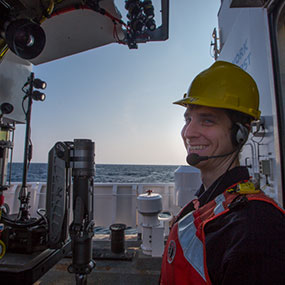
Systems/Robotics Engineer
Global Foundation for Ocean Exploration
Bobby Mohr is a Systems/Robotics Engineer, specializing in autonomous and remotely operated underwater vehicles. He holds a B.S. in physics and graduated cum laude from Davidson College in 2009. Bobby started his career as an engineering technician with Greensea Systems where he was responsible for the design, development, and testing of autonomous underwater vehicle control systems. Like many of our engineers, Bobby realized that he would enjoy the design-build process more if he was able to also pursue the challenges of making vehicles work successfully at sea.
After serving on several projects at Greensea where he specialized in electrical and software systems support, Bobby joined the Ocean Exploration program as an electrical systems engineer. During his time at Greensea and now with NOAA, he has been one of the key electrical engineers on the development of our 6000-meter-rated remotely operated vehicle system, Deep Discoverer and Seirios. Like many of our engineers, he has multiple skills and is a tremendous asset to our program.
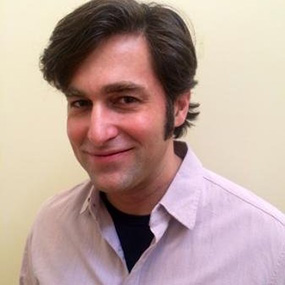
Legs 2, 3, 4
Software/Data and Satellite Engineer - ROV Pilot/Copilot
Andy started his professional career in the U.S. Navy where he ran a small electronic test system calibration laboratory and instructed NATO students in Satellite Ground Station repair. Following the Navy, he obtained a B.A. in History and a M.S. in Computer Science from the University of Vermont before hiring on as the Lead Software Engineer at Greensea Systems. During his tenure at Greensea, Andy designed, developed, and supported over 40 widely varying custom robot control systems and their operator interfaces for government and industry. Notably, Andy was the software lead on our very own Deep Discoverer and Seirios remotely operated vehicles.
Andy reports he so enjoyed working with the NOAA Office of Ocean Exploration and Research team, and their exploration mission, that he asked to join. Andy now splits his time between developing software; managing science and engineering data; maintaining the satellite communications system; and navigating, piloting, and co-piloting the deep-submergence vehicles. During his free time you can often find him in Monkton, Vermont.
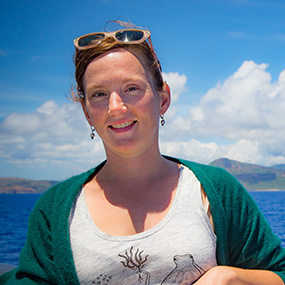
Legs 3, 4
Physical Scientist, Office of Coast Survey, Pacific Hydrographic Branch
Annie Raymond studied Geography at Western Washington University and has worked for NOAA for the last 14 years. She has worked in almost all the various offices within Coast Survey and currently works on the Cartographic Team at the Pacific Hydrographic Branch in Seattle, Washington, where her primary duties consist of supporting NOAA hydrographic survey vessels and creating cartographic products for nautical charting. She's recently been involved with efforts to design and produce new high-resolution bathymetric charting products to advance modern electronic charting and precision navigation tools. Ms. Raymond has sailed all along the west coast of the U.S. from Los Angles as far north as Nome, Alaska, on board the NOAA Ships Fairweather and Rainier and on the NOAA Ships Thomas Jefferson and Bay Hydro on the east coast. This is her second time supporting mapping efforts on the Okeanos Explorer and first time sailing in Hawaiian waters. In her free time she enjoys traveling, biking, hiking, motorcycling, sailing, gardening, and all things creative and out of doors.
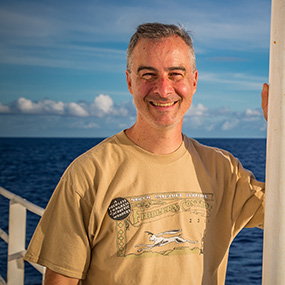
Leg 3
Technical Development Team Lead NOAA National Centers for Environmental Information
John Relph is a systems and software specialist at the National Centers for Environmental Information, based in Silver Spring, Maryland. He is responsible for the development and deployment of systems to move large quantities of environmental data into and through the long term archives so that the data are available for public use, now and into the future. John is working with the Office of Ocean Exploration and Research data management team to develop state of the art automated workflows for managing the vast quantities of video captured during telepresence operations on board NOAA Ship Okeanos Explorer. Before joining NOAA, John worked in Silicon Valley as a software engineer for nearly two decades, delivering bulletproof consumer software in the highly competitive private sector. John earned his B.S. in Computer Science from the University of Southern California. In his spare time, John is a semi-professional bluegrass mandolinist, playing in multiple bands in the Washington, DC, area. He is an enthusiastic amateur chef, mixologist, birdwatcher and unicyclist, and likes to travel the world.
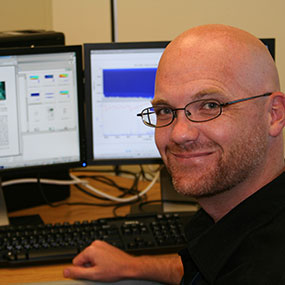
Legs 2, 3
Oceanographer/Data Manager, NOAA Office of Ocean Exploration and Research
Brendan Reser is an oceanographer responsible for integrating telepresence with data management aboard NOAA Ship Okeanos Explorer. He ensures that exploration data collections are accessible to shoreside participants during and after the expedition. Brendan specializes in automating processes and in developing unique data display capabilities. Prior to joining NOAA, Brendan was involved in field sampling and data management efforts in response to the Deepwater Horizon incident. Brendan has a Master of Science degree in Oceanography from Oregon State University and a Bachelor of Science degree in Biology from the University of New Mexico. He is currently employed by Riverside Technology, Inc., and is contracted to support NOAA's Office of Ocean Exploration and Research through NOAA’s National Centers for Environmental Information at Stennis Space Center, Mississippi.
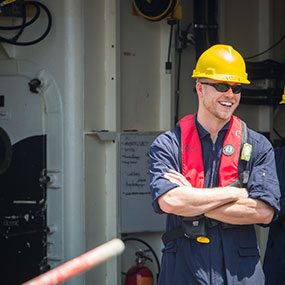
Legs 3, 4
Ocean Engineer
Chris first joined our group on the Cayman Rise Expedition in 2011, just prior to being hired full time by NAVSEA. Since then, an informal NAVSEA-NOAA relationship has allowed Chris to continue to participate in our design, engineering, and offshore operations. Chris holds a B.S. in Ocean Engineering and a B.S. in Aerospace Engineering from Virginia Tech with a minor in mathematics. He is currently working on his M.S. in Ocean Engineering at Virginia Tech and expects to complete that program in 2015. Chris has been a major contributor to our design-build process and a tremendous asset to our offshore operations. He is a skilled navigator, pilot, and co-pilot of our vehicles and brings with him a level of enthusiasm that everyone around him appreciates and respects. The Office of Ocean Exploration and Research is very lucky to have his participation and we applaud NAVSEA for their insight, training, and willingness to share great talent. Chris resides in Arlington, Virginia.
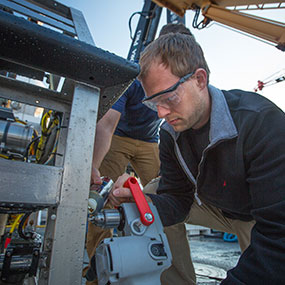
Legs 2, 3, 4
ROV Engineer and Telepresence Team Member
Daniel Rogers brings with him a diverse background in engineering, media production, and education. Daniel holds a B.S. in physics and received an M.S. in mechanical engineering from the University of Hawaii in 2013. His graduate work focused on the development and evaluation of an autonomous marine vessel designed for port and harbor security missions. Before starting his graduate program, Daniel worked as a science educator at the Bishop Museum in Honolulu where he continued as a digital media producer while in school. A lifelong interest in the sciences inspires him to learn all he can about the natural world and he is passionate about sharing the drama, allure, and wonder of scientific inquiry with others. Daniel currently works as a media producer and autonomous systems engineer in Honolulu, Hawaii.
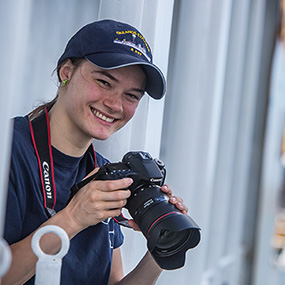
Legs 2, 3
Videographer/Filmmaker, Global Foundation for Ocean Exploration
Tara Smithee is the Media and Visual Arts Coordinator for the Global Foundation for Ocean Exploration. Tara holds an M.S. in Earth Systems, Ocean Track, from Stanford University and is currently pursuing a MFA degree in Science and Natural History Filmmaking at Montana State University’s Science and Natural History Film School.
To prepare for attending film school, she pursued a number of internships, spending three months learning to use editing software at NOAA's Ocean Media Center, one month filming wolves with Landis Wildlife films in Yellowstone National Park, and making several more trips working side by side with industry professionals on NOAA Ship Okeanos Explorer. In between her classes, Tara continues to participate in expeditions with the Okeanos and produces films for the NOAA Ocean Explorer website. She has worked on a variety of films as a producer, camera, sound, and editor. She hopes to use film to share her voice and as a platform for conservation. When not at sea, she resides in Portland, Oregon, where she rides horses, tango dances, and SCUBA dives.
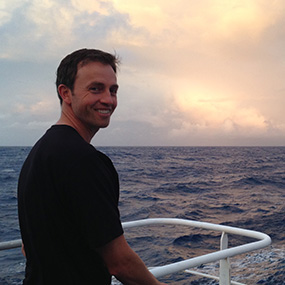
Legs 1, 3
Physical Scientist/Hydrographer, NOAA Office of Ocean Exploration and Research
Derek Sowers holds a B.S. in Environmental Science from the University of New Hampshire and an M.S. in Marine Resource Management from Oregon State University. He has 14 years of previous coastal research and management experience, including work for NOAA’s National Estuarine Research Reserve network and the Environmental Protection Agency’s National Estuary Program in both Oregon and New Hampshire. Derek has participated in ocean research expeditions in the Arctic Ocean, Gulf of Maine, Gulf of Mexico, Pacific Northwest continental shelf, North Atlantic Canyons, and New England Seamounts.
During at-sea expeditions, Derek leads sonar data collection by planning the ship’s mapping routes and producing maps of seafloor and water column features to guide exploration. On shore, Derek works at the Center for Coastal and Ocean Mapping/Joint Hydrographic Center at the University of New Hampshire to coordinate future mapping expeditions, process and archive data, and collaborate with other scientists. Derek is also a part-time Oceanography Ph.D. student focused on using Extended Continental Shelf and Okeanos Explorer data to develop marine ecological classification maps.
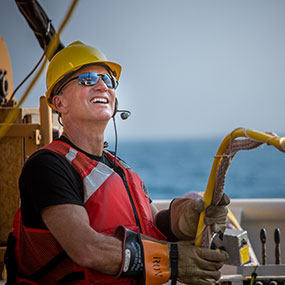
Legs 2, 4
Electrical Engineer
With five U.S. patents and multiple publications outlining autonomous underwater vehicle (AUV) research under his belt, Jeff Williams has contributed more than his fair share to ocean exploration and engineering. Williams graduated from the Rochester Institute of Technology with an Electrical Engineering Degree, Highest Honors, and a driving sense of curiosity and adventure. After working as an engineer for firms including Raytheon and Ascom/Timeplex, Jeff set out to circumnavigate the globe; a voyage that would take him 40,000 miles and five years to complete.
It is at the convergence of this knowledge, skill, and experience that Jeff was to become an autonomous and remote underwater vehicle specialist. An accomplished pilot, navigator, and engineer, Jeff has a holistic understanding of the systems and techniques required to explore one of the most unforgiving environments on our planet. In 2010, Jeff worked with the National Research Council Canada to deploy an AUV for 10 days under Canadian Arctic Ice, an expedition risky to equipment and personnel alike. And while Jeff works in some of the most inhospitable environments on the planet, his up-beat disposition and sense of humor make him a pleasure to work with. He has been with theOkeanos Explorer program since 2011 where he's helped explore the deepest portions of the Mid-Cayman Rise, Galapagos Spreading Center, Gulf of Mexico, and Northeast Canyons.
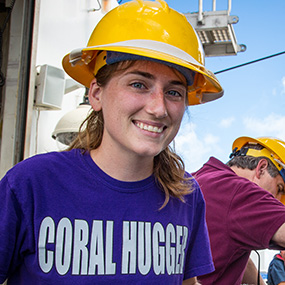
Scientist/Data Manager
General Dynamics Information Technology
Katharine Woodard currently works as a scientist and data content manager for NOAA's National Centers for Environmental Information where she prepares geospatial data packages for long-term archiving and determines best practices for submission. Her past research experience includes looking at bio-physical interactions with emphasis on mesoscale eddies in the Gulf of Mexico using an integrated satellite sensor approach, and research at the ASIST wave-tank at the University of Miami with the Oceans and Human Health project. She received her M.S. in Physical Oceanography from the University of Southern Mississippi and a B.S. in Marine Science and Biology from the University of Miami. Katharine brings a diverse skill to the team, including data collection and management, sample handling and processing, data analysis, troubleshooting and writing scripts, knowledge of multiple programming languages and platforms, and geographic information systems. She is joining the team during this cruise leg to help with sample processing and data management.
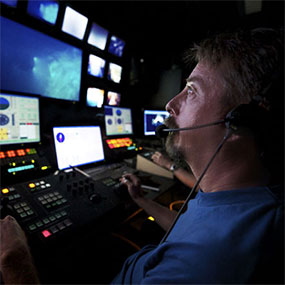
Legs 2, 3, 4
Electrical Engineer
Dave Wright joined the Ocean Exploration Program in 2009, bringing a set of skills that most would envy. A self-taught engineer, he is highly respected in the field of underwater technology, having spent a great deal of time working with Dr. Robert Ballard at the Institute for Exploration and as a valued member of the Monterey Bay Aquarium Research Institute. Dave is one of our senior pilots and in addition to being an outstanding and invaluable electrical engineer, he is one of our most valued and respected mentors to the younger generation we seek to train. Dave is a veteran of some of the earlier Ocean Exploration projects, having served as pilot on the 2004 Titanic cruise, the 2004 and 2005 Mountains in the Sea cruises, and the 2005 cruise to Lost City. He is a co-inventor of the 'Aquatic Autosampler,' a fully automated system for in situ species identification of toxic phytoplankton, which was developed while he worked at the Monterey Bay Aquarium Institute. When not on assignment with Ocean Exploration, Dave resides in Louisville, Kentucky.